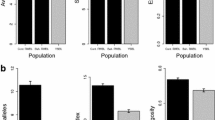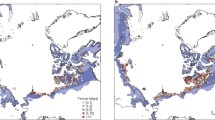Abstract
Understanding how population density influences mating systems may lead to important insights into the plasticity of breeding behavior, but few natural systems allow for such studies. Antarctic fur seals (Arctocephalus gazella) provide an interesting model system because they breed in colonies of varying densities. Previous studies have largely focused on a high-density site at Bird Island, South Georgia. Here, 13 highly polymorphic microsatellite loci were used to conduct a genetic analysis of a low-density breeding colony of this species at Livingston Island, approximately 1,600 km south of South Georgia. The majority of adults seen ashore (n = 54) were sampled together with every pup born (n = 97) over four consecutive years. Paternities were confidently assigned for 34 out of the 97 pups. Two out of 23 sampled males accounted for the paternity of 28 % of all pups sampled during the study and 82 % of the pups with an assigned father. Moreover, a full likelihood pedigree inference method assigned a further eight paternities to a single unsampled male seal that is inferred to have held a territory during the season before the study began. The most successful males in our study easily surpassed the previous record for the total number of pups sired per male seal for the species. Furthermore, we identified two triads of full siblings implying that their parents remated in three consecutive years. These findings suggest that territorial male fur seals may achieve greater success in monopolizing access to breeding females when population density is relatively low.


Similar content being viewed by others
References
Amos W, Twiss S, Pomeroy P, Anderson S (1995) Evidence for mate fidelity in the gray seal. Science 268:1897–1899
Amos W, Wilmer J, Kokko H (2001) Do female grey seals select genetically diverse mates? Anim Behav 62:157–164
Arnould JPY, Duck CD (1997) The cost and benefits of territorial tenure, and factors affecting mating success in male Antarctic fur seals. J Zool 241:649–664
Bartholomew GA (1970) A model for the evolution of pinniped polygyny. Evolution 24:546–559
Bonin CA, Goebel ME, O’Corry-Crowe GM, Burton RS (2012) Twins or not? Genetic analysis of putative twins in Antarctic fur seals, Arctocephalus gazella, on the South Shetland Islands. J Exp Mar Biol Ecol 412:13–19
Bonin CA, Goebel ME, Forcada J, Burton RS, Hoffman I (2013) Unexpected genetic differentiation between recently recolonized populations of a long-lived and highly vagile marine mammal. Ecol Evol 3:3701–3712
Boveng PL, Hiruki LM, Schwartz MK, Bengtson JL (1998) Population growth of Antarctic fur seals: limitation by a top predator, the leopard seal? Ecology 79:2863–2877
Boyd IL (1993) Pup production and distribution of breeding Antarctic fur seals (Arctocephalus gazella) at South Georgia. Antarct Sci 5:17–24
Campbell RA, Gales NJ, Lento GM, Baker CS (2008) Islands in the sea: extreme female natal site fidelity in the Australian sea lion, Neophoca cinerea. Biol Lett 4:139–142
Clutton-Brock T (1989) Mammalian mating systems. Proc R Soc Lond B 236:339–372
Coltman DW, Bowen WD, Wright JM (1996) PCR primers for harbour seal (Phoca vitulina concolour) microsatellites amplify polymorphic loci in other pinniped species. Mol Ecol 5:161–163
Davis CS, Gelatt TS, Siniff D, Strobeck A (2002) Dinucleotide microsatellite markers from the Antarctic seals and their use in other Pinnipeds. Mol Ecol Notes 2:203–208
Doidge DW, Croxall JP, Baker JR (1984) Density-dependent pup mortality in the Antarctic fur seal Arctocephalus gazella at South Georgia. J Zool 202:449–460
Emlen S, Oring L (1977) Ecology, sexual selection, and evolution of mating systems. Science 197:215–223
Fabiani A, Galimberti F, Sanvito S, Hoelzel R (2006) Relatedness and site fidelity at the southern elephant seal, Mirounga leonina, breeding colony in the Falkland Islands. Anim Behav 72:617–626
Gemmell NJ, Allen PJ, Goodman SJ, Reed JZ (1997) Interspecific microsatellite markers for the study of pinniped populations. Mol Ecol 6:661–666
Grandi MF, Dans SL, Crespo EA (2008) Social composition and spatial distribution of colonies in an expanding population of South American sea lions. J Mammal 89:1218–1228
Harcourt RG, Kingston JJ, Cameron MF, Waas JR, Hindell MA (2007) Paternity analysis shows experience, not age, enhances mating success in an aquatically mating pinniped, the Weddell seal (Leptonychotes weddellii). Behav Ecol Sociobiol 61:643–652
Hernandez-Velazquez FD, Galindo-Sanchez CE, Taylor MI, De La Rosa-Velez J, Cote IM, Schramm Y, Aurioles-Gamboa D, Rico C (2005) New polymorphic microsatellite markers for California sea lions (Zalophus californianus). Mol Ecol Notes 5:140–142
Hoelzel AR, Le Boeuf BJ, Reiter J, Campagna C (1999) Alpha-male paternity in elephant seals. Behav Ecol Sociobiol 46:298–306
Hoffman JI, Amos W (2005) Microsatellite genoty** errors: detection approaches, common sources and consequences for paternal exclusion. Mol Ecol 14:599–612
Hoffman JI, Forcada J (2012) Extreme natal philopatry in female Antarctic fur seals (Arctocephalus gazella). Mammal Biol 77:71–73
Hoffman JI, Boyd IL, Amos W (2003) Male reproductive strategy and the importance of maternal status in the Antarctic fur seal Arctocephalus gazella. Evolution 57:1917–1930
Hoffman JI, Boyd IL, Amos W (2004) Exploring the relationship between parental relatedness and male reproductive success in the Antarctic fur seal Arctocephalus gazella. Evolution 58:2087–2099
Hoffman JI, Forcada J, Amos W (2006a) No relationship between microsatellite variation and neonatal fitness in Antarctic fur seals Arctocephalus gazella. Mol Ecol 15:1995–2005
Hoffman JI, Trathan PN, Amos W (2006b) Genetic tagging reveals extreme site fidelity in territorial male Antarctic fur seals Arctocephalus gazella. Mol Ecol 15:3841–3847
Hoffman JI, Forcada J, Trathan PN, Amos W (2007) Female fur seals show active choice for males that are heterozygous and unrelated. Nature 445:912–914
Hoffman JI, Hanson N, Forcada J, Trathan PN, Amos W (2010) Getting long in the tooth: a strong positive correlation between canine size and heterozygosity in the Antarctic fur seal Arctocephalus gazella. J Hered 101:527–538
Hoffman JI, Grant SM, Forcada J, Phillips CD (2011) Bayesian inference of a historical bottleneck in a heavily exploited marine mammal. Mol Ecol 20:3989–4008
Hucke-Gaete R, Osman LP, Moreno CA, Torres D (2004) Examining natural population growth from near extinction: the case of the Antarctic fur seal at the South Shetlands, Antarctica. Polar Biol 27:304–311
Jones OR, Wang J (2010) COLONY: a program for parentage and sibship inference from multilocus genotype data. Mol Ecol Resour 10:551–555
Kiyota M, Insley S, Lance S (2008) Effectiveness of territorial polygyny and alternative mating strategies in northern fur seals, Callorhinus ursinus. Behav Ecol Sociobiol 62:739–746
Le Boeuf BJ (1974) Male-male competition and reproductive success in elephant seals. Am Zool 14:163–176
Marshall TC, Slate J, Kruuk LEB, Pemberton JM (1998) Statistical confidence for likelihood-based paternity inference in natural populations. Mol Ecol 7:639–655
Miller SA, Dykes DD, Polesky HF (1988) A simple salting out procedure for extracting DNA from human nucleated cells. Nucleic Acids Res 16:1215
Poland VF, Pomeroy PP, Twiss SD, Graves JA (2008) Fine-scale study finds limited evidence of kin clustering in a gray seal colony. Mar Mamm Sci 24:371–387
Reid K, Forcada J (2005) Causes of offspring mortality in the Antarctic fur seal, Arctocephalus gazella: the interaction of density dependence and ecosystem variability. Can J Zool 83:604–609
Twiss SD, Thomas C, Poland V, Graves JA, Pomeroy P (2007) The impact of climatic variation on the opportunity for sexual selection. Biol Lett 3:12–15
Wang J, Santure AW (2009) Parentage and sibship inference from multilocus genotype data under polygamy. Genetics 181:1579–1594
Worthington Wilmer JW, Overall AJ, Pomeroy PP, Twiss SD, Amos W (2000) Patterns of paternal relatedness in British grey seal colonies. Mol Ecol 9:283–292
Acknowledgments
C.A. Bonin is supported by the National Science Foundation-Integrative Graduate Education and Research Traineeship Program grant # 0903551 awarded by the Center for Marine Biodiversity and Conservation, Scripps Institution of Oceanography. The United States Antarctic Marine Living Resources Program provided resources for field and laboratory work; we especially thank Dr. Rennie Holt and George Watters for supporting this research. Laboratory infra-structure was provided by Protected Resources Division, Southwest Fisheries Science Center, National Oceanic and Atmospheric Administration, La Jolla, CA. We are grateful to the ‘Programa Antártico Brasileiro’ (PROANTAR) and the ‘Ministério da Ciência and Technologia do Brasil’ for transportation of CA Bonin from Punta Arenas to Cape Shirreff during the 2009–2010 field season. Invaluable field assistance was provided by Ryan Burner, Raymond Buchheit, and Birgitte MacDonald. Drs. Eric Lewallen and Phil Morin provided valuable comments on the previous versions of this manuscript.
Ethical standards
All sampling procedures were conducted in full compliance with Marine Mammal Protection Permit No. 774-1847-03 granted by the Office of Protected Resources, National Marine Fisheries Service, USA. All animal tissues were transported from Antarctica in accordance with the international laws and are currently stored at the Marine Mammal and Marine Turtle Molecular Research Collection at the same institution, under the US national and international permits granted to the Protected Resources Division and the Antarctic Ecosystem Research Division at the Southwest Fisheries Science Center, National Oceanic and Atmospheric Administration, La Jolla, CA, USA.
Author information
Authors and Affiliations
Corresponding author
Additional information
Communicated by V. M. Janik
Electronic supplementary material
Below is the link to the electronic supplementary material.
ESM 1
(DOCX 22 kb)
Rights and permissions
About this article
Cite this article
Bonin, C.A., Goebel, M.E., Hoffman, J.I. et al. High male reproductive success in a low-density Antarctic fur seal (Arctocephalus gazella) breeding colony. Behav Ecol Sociobiol 68, 597–604 (2014). https://doi.org/10.1007/s00265-013-1674-7
Received:
Revised:
Accepted:
Published:
Issue Date:
DOI: https://doi.org/10.1007/s00265-013-1674-7




